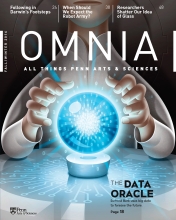In outer space, big data meets infinite information. How can we measure the expansion of the universe? Can we find gravitational waves that trace back to the Big Bang? Are there other planets that can sustain life? Now, after years—sometimes decades—of planning and technological development, three major U.S. astrophysics projects will address these questions, and Penn scientists have a major role in all three.
“We’re pushing on different forms of technology in ways that haven’t been done before because no one has ever had datasets as large as this,” says Larry Gladney, Penn Arts and Sciences’ Associate Dean for the Natural Sciences, Edmund J. and Louise W. Kahn Professor for Faculty Excellence, and professor of physics and astronomy. “We’ve only recently understood that we could achieve this.”
Now under construction in Chile, the Large Synoptic Survey Telescope (LSST) will have a 3.5 billion pixel camera to survey and photograph large areas of the sky all night, every night, for 10 years. This “time domain astronomy” will let scientists see the development of the universe over six billion years of its history.
Penn scientists involved in LSST are Gladney; Bhuvnesh Jain, Walter H. and Leonore C. Annenberg Professor in the Natural Sciences; Mike Jarvis, a research scientist in physics and astronomy; Gary Bernstein, Reese W. Flower Professor of Astronomy and Astrophysics; and Masao Sako, associate professor of physics and astronomy. Jain led the project’s cosmology effort as a spokesperson for its Dark Energy Science Collaboration, while Jarvis is co-coordinator of its weak gravitational lensing working group. LSST should start being used in 2019, with science operations beginning in 2022.
Penn is also part of a group awarded a $38.4 million grant by the Simons Foundation to establish an observatory in Chile's Atacama Desert that will investigate cosmic microwave background radiation to study the evolution of the universe.
The cosmic microwave background is the last glow given off by the cooling universe after the Big Bang, and it contains the signature of the primordial gravitational waves that were produced by that event, says Gladney. Mark Devlin, Reese W. Flower Professor of Astronomy and Astrophysics, is a specialist in the design and construction of novel telescopes and cryogenic receivers operating at millimeter and submillimeter wavelengths. “Over decades of time, you can eliminate all other sources of radiation, and what’s left is so sensitive that we can infer the physics occurring a trillionth of a trillionth of a trillionth of a second after the Big Bang,” says Gladney. “This is not science fiction. It’s science literally written in the sky—it’s amazing.”
The third project will send a telescope into space itself, providing a field of view of the sky that is 100 times larger than the images from the Hubble Space Telescope and eliminates interference from the earth’s weather and atmosphere. The Wide Field Infrared Survey Telescope (WFIRST) will take advantage of a particular type of supernova that explodes with a nearly fixed amount of energy. Scientists can use this consistency to measure the distance to the supernova and, by measuring the redshift of its radiation, know how far away it should be, based on what we know about the history of the universe. By contrasting these numbers, they can learn more about how the expansion of the universe has been changing.
“The sky is very cluttered. You’re looking through a lot of other stars and galaxies to see the targets, which are billions of light years away,” says Gladney. Bhuvnesh Jain is leading one of the two teams responsible for defining the six-year mission of WFIRST, which will include measuring light from a billion galaxies and performing a survey of the inner Milky Way to discover planets outside our solar system.




